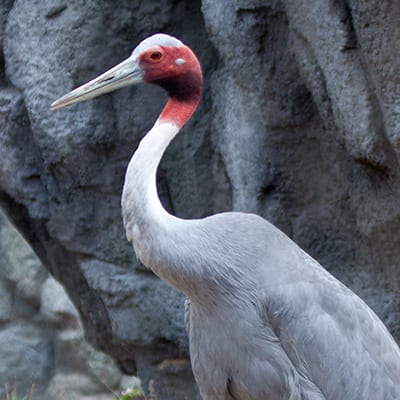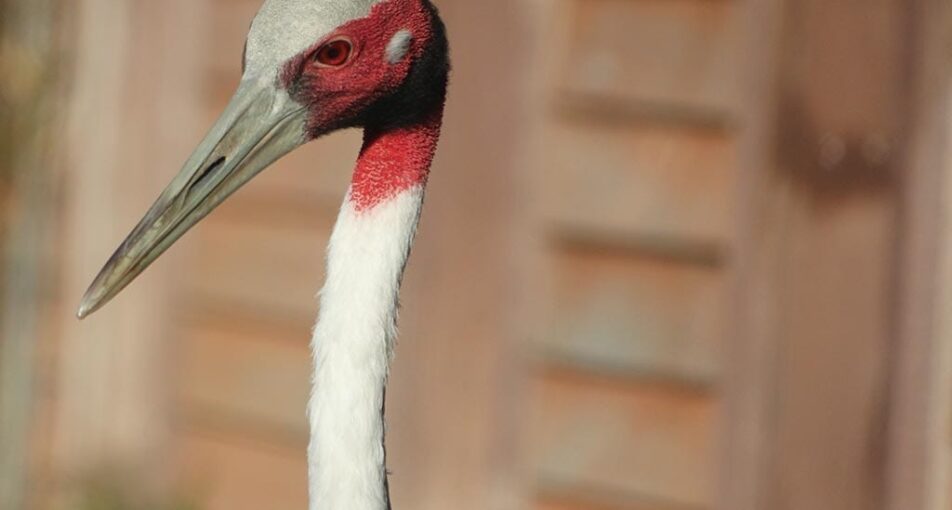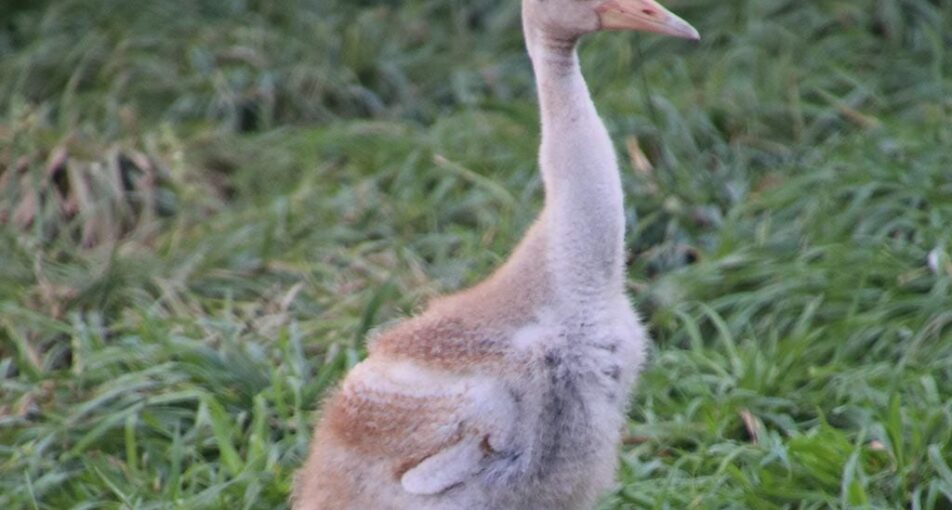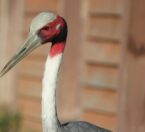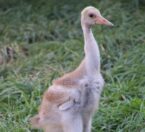Cranes make loud trumpeting calls that carry for several miles. Their windpipe is lengthened by coiling within the breastbone, which amplifies their sounds. The most well-known crane call is the unison call made by paired adults to establish and announce their territory. Adult cranes can also make a range of sounds from hissing to purrs to screams. Chicks and juvenile cranes make a low clear “peep” which is repeated at short intervals.
Classification
| CLASS: | Aves |
| ORDER: | Gruiformes |
| FAMILY: | Gruidae |
| GENUS: | Grus |
| SPECIES: | antigone |
Habitat & Range
Wetland habitats including marshes, swamps and flooded fields.
The sarus crane is found in three distinct populations: northern Australia, southeastern Asia (Cambodia, Vietnam, Myanmar) and the Indian subcontinent (Pakistan, India, Nepal).
Location


Adaptations
- So You Think You Can Dance
- Before mating, paired cranes engage in intensive periods of elaborate dance moves that include head bobbing, leaping, deep bowing, running with wings flapping and short ritual flights accompanied by loud trumpeting calls. Juvenile birds engage in “social dancing” that helps develop pair bonds. Even downy chicks mimic the adult dance moves! Dancing is not just a mating behavior. Elegant displays of carefully orchestrated dances occur during the non-breeding season when one pair begins a display, which then spreads through the entire flock.
- How White Your Eggs Are
- Sarus cranes lay bright white eggs. This species breeds in tropical and subtropical areas where temperatures are sometimes so hot that exposure to sunlight is a threat to the survival of the embryo. As a result, these cranes must shade their eggs from the sun. The light color of the eggs might help deflect heat from sunlight. In contrast, cranes that breed in the coldest areas (lesser sandhill, Siberian, and black-necked) have the darkest eggs, perhaps an adaptation to absorb more heat from sunlight.
- Crane Calls
- Cranes make loud trumpeting calls that carry for several miles. Their windpipe is lengthened by coiling within the breastbone, which amplifies their sounds. The most well-known crane call is the unison call made by paired adults to establish and announce their territory. Adult cranes can also make a range of sounds from hissing to purrs to screams. Chicks and juvenile cranes make a low clear “peep” which is repeated at short intervals.
Physical Description
- Sarus cranes stand up to six feet tall (1.8 m).
- They weigh 11-26 pounds (5-12 kg) – males are larger than females.
- They have a wingspan of 8.5 feet (2.6 m).
- They have gray wings and body, a bare red head and upper neck with a narrow band of bristle black feathers, a white crown and black wingtips.
- Juveniles have darker gray body feathers and buff colored feathers on the head.
- They have a long, dark pointed bill.
- They have long pale red legs.
Diet
What Does It Eat?
In the wild:
Frogs, lizards, grasshoppers, seeds, grains, cereal crops like rice, insects, aquatic plants, fish, water snakes and eggs of other birds.
At the zoo:
specialized crane pellets, meat diet and large mealworms
What Eats It?
Birds including crows and kites prey on eggs; dingos, foxes or feral dogs prey on chicks.
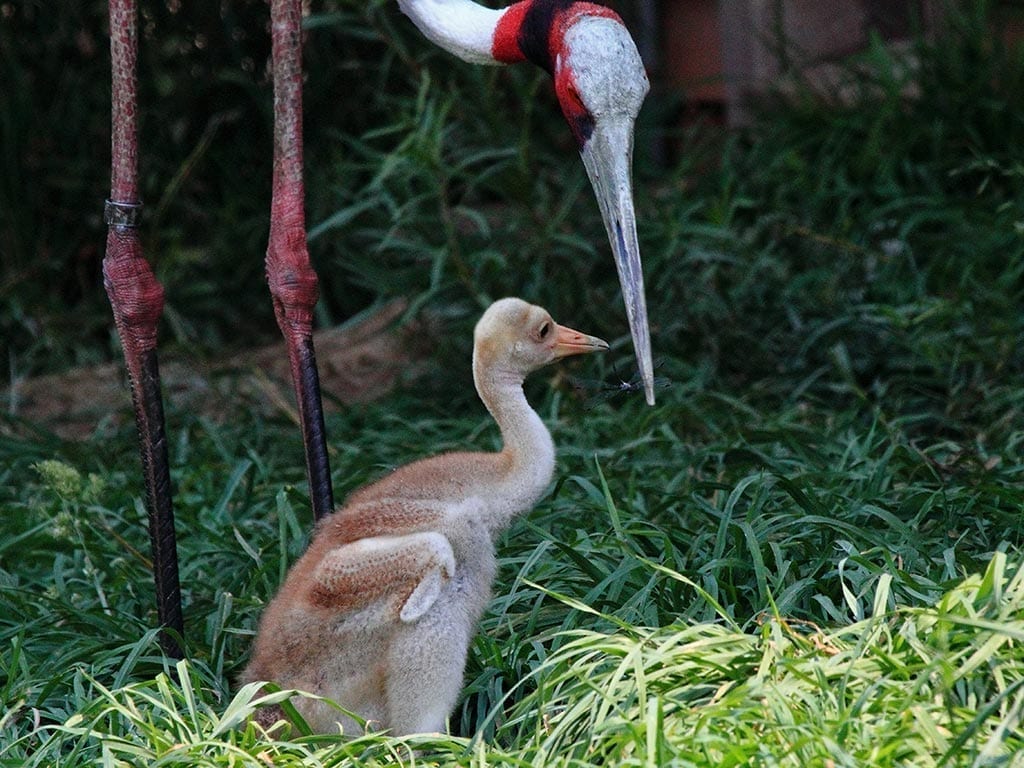
Social Organization
Sarus cranes are usually seen in pairs or family groups. They may congregate in large flocks of up to 200 birds during non-breeding season. Non-breeding birds may stay in flocks until they find a mate and establish a breeding territory.
Life Cycle
Sarus cranes are monogamous mating for life. During the breeding season, mated pairs perform loud trumpeting calls and elaborate dance moves. Mated pairs establish a nesting territory and build a large nest in a wet marsh or paddy field. The nest can be more than six feet in diameter and three feet high. Nests may be reused year after year. The female lays a clutch of one or two eggs and both parents share incubation duties – females at night and males during the day. The eggs hatch after about 27-35 days. Newly hatched chicks are well developed when they hatch and they are immediately able to follow the adults around the shallows until they develop flight feathers at two to four months of age. After they fledge they remain with their parents until the next breeding season and then disperse. Because of predation of both eggs and young chicks, the breeding success rate for sarus cranes is estimated at only 20%. Sarus cranes may live up to 42 years in captivity.
